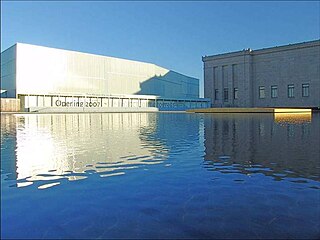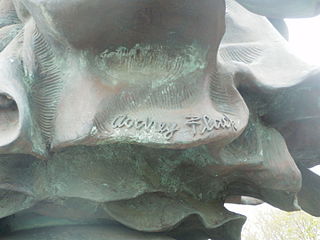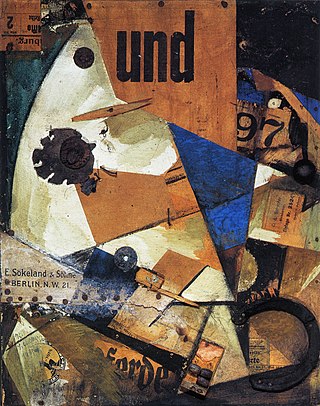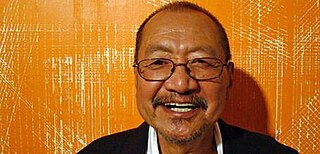Related Research Articles

The Solomon R. Guggenheim Foundation is a nonprofit organization founded in 1937 by philanthropist Solomon R. Guggenheim and his long-time art advisor, artist Hilla von Rebay. The foundation is a leading institution for the collection, preservation, and research of modern and contemporary art and operates several museums around the world. The first museum established by the foundation was The Museum of Non-Objective Painting, in New York City. This became The Solomon R. Guggenheim Museum in 1952, and the foundation moved the collection into its first permanent museum building, in New York City, in 1959. The foundation next opened the Peggy Guggenheim Collection in Venice, Italy, in 1980. Its international network of museums expanded in 1997 to include the Guggenheim Museum Bilbao in Bilbao, Spain, and it expects to open a new museum, Guggenheim Abu Dhabi, in the United Arab Emirates after its construction is completed.

The Nelson-Atkins Museum of Art is an art museum in Kansas City, Missouri, known for its encyclopedic collection of art from nearly every continent and culture, and especially for its extensive collection of Asian art.

Assemblage is an artistic form or medium usually created on a defined substrate that consists of three-dimensional elements projecting out of or from the substrate. It is similar to collage, a two-dimensional medium. It is part of the visual arts and it typically uses found objects, but is not limited to these materials.

Shūsaku Arakawa was a Japanese conceptual artist and architect. He had a personal and artistic partnership with the writer and artist Madeline Gins that spanned more than four decades in which they collaborated on a diverse range of visual mediums, including: painting & printmaking, experimental filmmaking, performance art, and architectural & landscape design.

The Jane Voorhees Zimmerli Art Museum is located on the Voorhees Mall of the campus of Rutgers University in New Brunswick, New Jersey. The museum houses more than 60,000 works, including Russian and Soviet Nonconformist Art from the acclaimed Dodge Collection, American art from the eighteenth century to the present, and six centuries of European art with a particular focus on nineteenth-century French art. The museum also is noted for its holdings of works on paper, including prints, drawings, photographs, original illustrations for children's books, and rare books.

Raymond Saunders is an American artist known for his multimedia paintings which often have sociopolitical undertones, and which incorporate assemblage, drawing, collage and found text. Saunders is also recognized for his installation, sculpture, and curatorial work.

Audrey Flack is an American artist. Her work pioneered the art genre of photorealism and encompasses painting, printmaking, sculpture, and photography.
Walter "Chico" Hopps was an American museum director, gallerist, and curator of contemporary art. Hopps helped bring Los Angeles post-war artists to prominence during the 1960s, and later went on to redefine practices of curatorial installation internationally. He is known for contributing decisively to “the emergence of the museum as a place to show new art.”
Kim Adams is a Canadian sculptor who is known for his assemblages combining prefabricated elements, often parts of cars or other machine-made structures. His visual style is influenced by industrial design, architecture and automotive design. His large-scale sculptures incorporate the model railroading technique of kitbashing, and bright stock colours. They may be shown in a park or street as well as in a museum setting. His small surreal landscapes are toy-sized, and may be installed on shelves.
Reginald Case was an American artist who made American Folk Art collages and Hollywood iconographic mixed-media assemblages and sculptures.

Collage is a technique of art creation, primarily used in the visual arts, but in music too, by which art results from an assemblage of different forms, thus creating a new whole.
Squeak Carnwath is an American contemporary painter and arts educator. She is a professor emerita of art at the University of California, Berkeley. She has a studio in Oakland, California, where she has lived and worked since 1970.
Sara VanDerBeek, is an American artist who lives and works in New York City. She is known for photographing sculptures and three-dimensional still-life assemblages of her own making, some of which she destroys after the photos have been taken, as well as for exploring the depiction of women in art history particularly classical or ancient sculpture.
The Guggenheim UBS MAP Global Art Initiative was a five-year program, supported by Swiss bank UBS in which the Solomon R. Guggenheim Foundation identified and works with artists, curators and educators from South and Southeast Asia, Latin America, and the Middle East and North Africa to expand its reach in the international art world. For each of the three phases of the project, the museum invited one curator from the chosen region to the Solomon R Guggenheim Museum in New York City for a two-year curatorial residency, where they worked with a team of Guggenheim staff to identify new artworks that reflect the range of talents in their parts of the world. The resident curators organized international touring exhibitions that highlight these artworks and help organize educational activities. The Foundation acquired these artworks for its permanent collection and included them as the focus of exhibitions that open at the museum in New York and subsequently traveled to two other cultural institutions or other venues around the world. The Foundation supplemented the exhibitions with a series of public and online programs, and supported cross-cultural exchange and collaboration between staff members of the institutions hosting the exhibitions. UBS reportedly contributied more than $40 million to the project to pay for its activities and the art acquisitions. Foundation director Richard Armstrong commented: "We are hoping to challenge our Western-centric view of art history."

Carlos Villa was a Filipino-American visual artist, curator and faculty member in the Painting Department at the San Francisco Art Institute. His work often explored the meaning of cultural diversity and sought to expand awareness of multicultural issues in the arts.

The Boise Art Museum (BAM) is located at 670 Julia Davis Drive in Boise, Idaho, and is part of a series of public museums and cultural attractions in Julia Davis Park. It is the permanent home of a growing collection of contemporary realism, modern and contemporary ceramics, as well as the largest public collection of works by acclaimed Idaho outsider artist and bookmaker James Charles Castle. The museum also features major traveling exhibitions and installations throughout the year.
Dyani White Hawk is a contemporary artist and curator of Sicangu Lakota, German, and Welsh ancestry based out of Minnesota. From 2010 to 2015, White Hawk was a curator for the Minneapolis gallery All My Relations. As an artist, White Hawk's work aesthetic is characterized by a combination of modern abstract painting and traditional Lakota art. White Hawk's pieces reflect both her Western, American upbringing and her indigenous ancestors mediums and modes for creating visual art.

JoAnne Carson is an American artist who is known for over-the-top, hybrid works in painting, sculpture and assemblage that freely mix fantasy, illusion and narrative, high and low cultural allusions, and seriocomic intent. She first gained widespread attention in the 1980s for what ARTnews critic Dan Cameron described as "extraordinary painted constructions—kaleidoscopic assemblages chock full of trompe-l’oeil painting, art-history quips, found objects and nostalgic echoes of early modernism." New York Times critic Roberta Smith wrote that Carson's subsequent work progressed methodically into three dimensions, culminating in freestanding botanical sculpture that exuded "giddy beauty" and "unapologetic decorativeness"; her later imaginary landscapes have been described as whimsical spectacles of "Disneyesque horror." Carson has been recognized with a Guggenheim Fellowship, awards from the American Academy of Arts and Letters, American Academy in Rome and National Endowment for the Arts, and Yaddo artist residencies. Her work has been exhibited at institutions including the Whitney Museum of American Art, Museum of Contemporary Art Chicago (MCA), Albright-Knox Gallery, New Orleans Museum of Art, and Institute of Contemporary Art, Philadelphia; it belongs to the public art collections of the Brooklyn Museum of Art, MCA Chicago, Frederick R. Weisman Art Foundation, and Modern Art Museum of Fort Worth, among others.

Michael Arcega is a San Francisco-based interdisciplinary artist who works mainly in sculpture and installation. Critics have described his work as a fusion of accessible materials, meticulous craftsmanship, politically barbed punning and conceptual rigor that balances light-hearted play with serious critique. His practice is informed by history, research, geography and his personal, insider-outsider sensibility as a naturalized Filipino-American; he frequently links historical eras and disparate geographies in order to address the present via the past. While visual, his art is often inspired by bilingual wordplay, jokes and jumbled signifiers. It explores cross-cultural exchange, colonization, sociopolitical dynamics and imbalances, and cultural markers embedded in objects, food, architecture, visual lexicons, and vernacular languages. Sculpture critic Laura Richard Janku wrote that Arcega "melds myriad aspects of past and present, high and low, humor and horror into the messy melting pot of history, politics and culture."
Jamal Cyrus is an American conceptual artist who works in a range of media, including drawing, sculpture, textiles, assemblage, installation, performance, and sound. His artistic and research practices investigates the history, culture, and identity of the United States, questioning conventional narratives and foregrounding Black political movements, social justice concerns, and the experiences and impact of the African diaspora, including Black music.
References
- 1 2 "Guggenheim Collection Online: Norberto Roldan". The Guggenheim Museums and Foundation. Retrieved 2023-05-16.
- 1 2 "Interview with Norberto Roldan". The Artling. 2014-05-12. Retrieved 2023-05-31.
- ↑ "Norberto Roldan repurposes religious objects for artistic ends" . Retrieved 2023-05-31.
- ↑ Artist Talk: Norberto Roldan , retrieved 2023-05-31
- ↑ "ARNDT - NORBERTO ROLDAN". www.arndtfineart.com. Retrieved 2023-05-31.
- ↑ "F-16". The Guggenheim Museums and Foundation. Retrieved 2023-05-31.
- ↑ "Norberto Roldan's painting in Guggenheim touring exhibit". Lifestyle.INQ. 2013-09-15. Retrieved 2023-06-01.
- 1 2 "Norberto 'Peewee' Roldan: How Artists Can Change Society". artreview.com. Retrieved 2023-05-31.